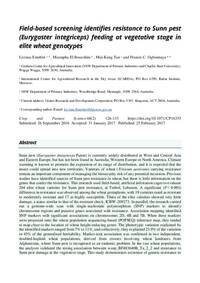Field-based screening identifies resistance to Sunn pest (Eurygaster integriceps) feeding at vegetative stage in elite wheat genotypes

Authors:
Sunn pest (Eurygaster integriceps Puton) is currently widely distributed in West and Central Asia
and Eastern Europe, but has not been found in Australia, Western Europe or North America. Climate
warming is known to promote the expansion of its range of distribution, and it is expected that the
insect could spread into new territories. Varieties of wheat (Triticum aestivum) carrying resistance
remain an important component of managing the biosecurity risk of any potential incursion. Previous
studies have identified sources of Sunn pest resistance in wheat, but there is little information on the
genes that confer the resistance. This research used field-based, artificial infestation cages to evaluate
204 elite wheat varieties for Sunn pest resistance, at Terbol, Lebanon. A significant (P < 0.001)
difference in resistance was observed among the wheat germplasm, with 19 varieties rated as resistant
to moderately resistant and 17 as highly susceptible. Three of the elite varieties showed very little
damage, a status similar to that of the resistant check, ICBW-209273. In parallel, the research carried
out a genome-wide scan with single-nucleotide polymorphism (SNP) markers to identify
chromosome regions and putative genes associated with resistance. Association mapping identified
SNP markers with significant associations on chromosomes 2D, 4B and 5B. When these markers
were projected onto the wheat population sequencing-based (POPSEQ) reference map, they tended
to map close to the location of wheat height-reducing genes. The phenotypic variation explained by
the identified markers ranged from 7% to 11%, and collectively, they explained 23.9% of the variation
or 45% of the generalised heritability. Marker-trait association was confirmed in two independent,
doubled-haploid wheat populations, derived from crosses involving wheat landraces from
Afghanistan, where Sunn pest is recognised as an endemic problem. In the two wheat populations,
the analyses validated the strong association between wsnp_BF483640B_Ta_2_2 and resistance to
Sunn pest damage at the vegetative stage. This study demonstrates existence of genetic resistance toSunn pest feeding at the vegetative stage in elite wheat germplasm. The study also identified and
validated SNP markers that could be useful tools for transfer of resistance into new wheat cultivars.
